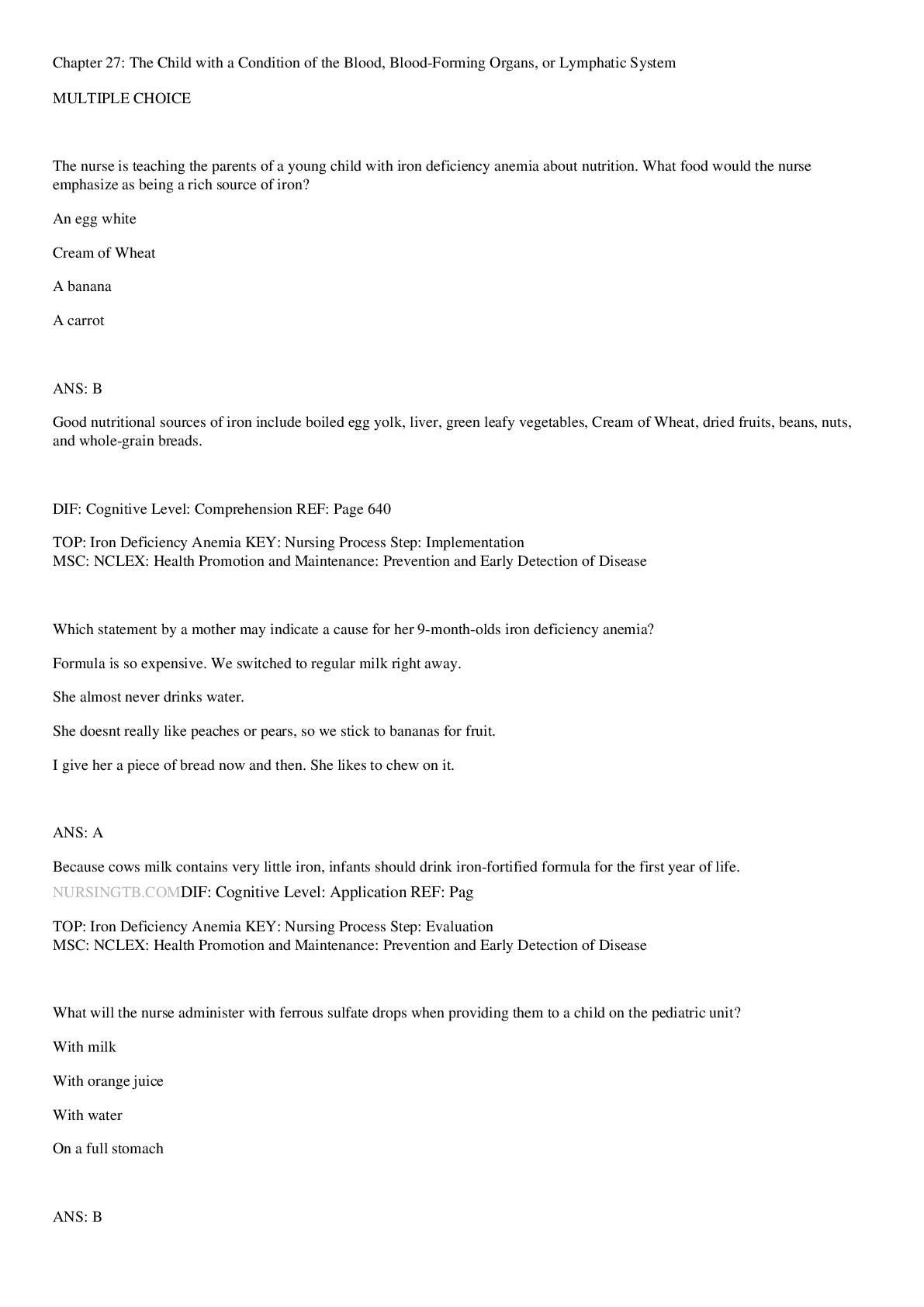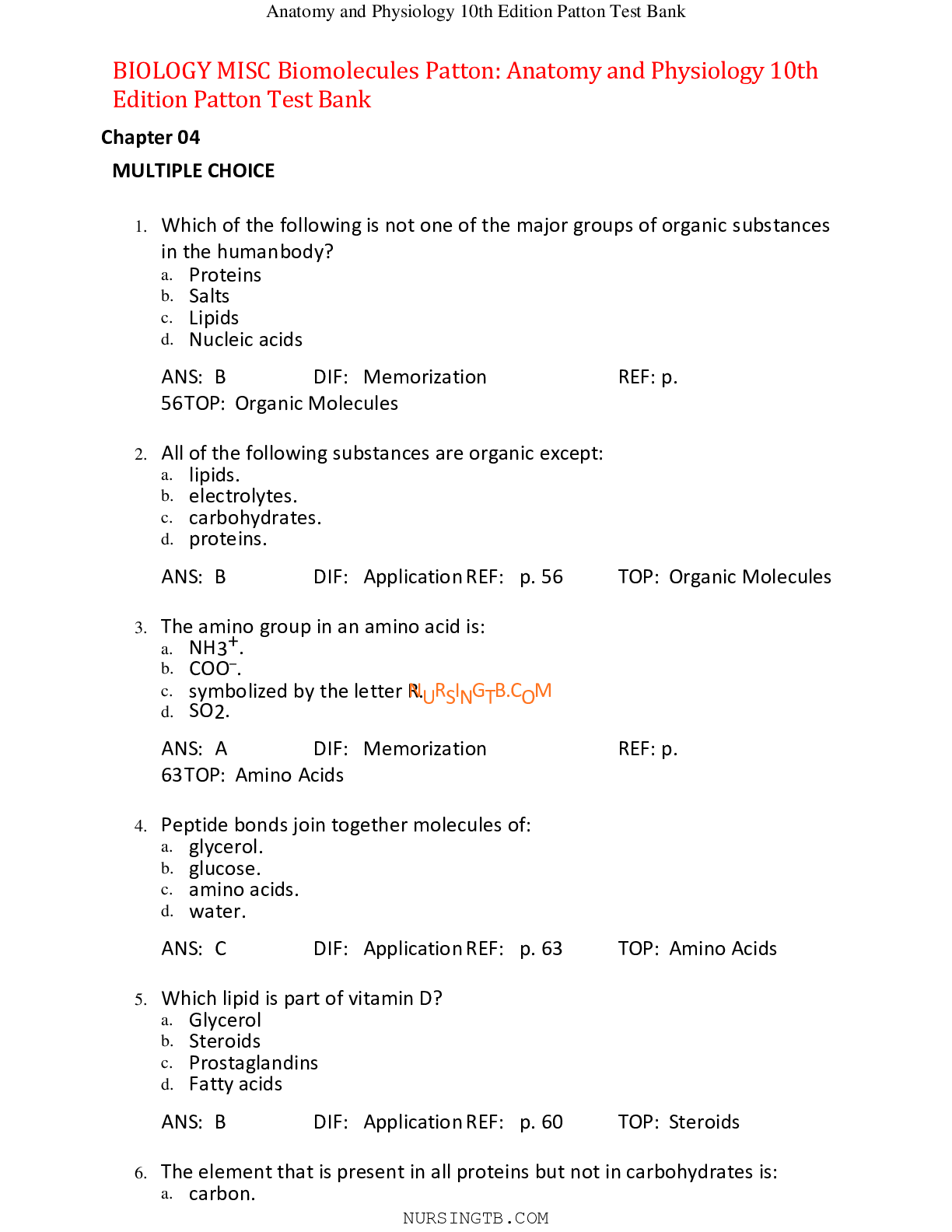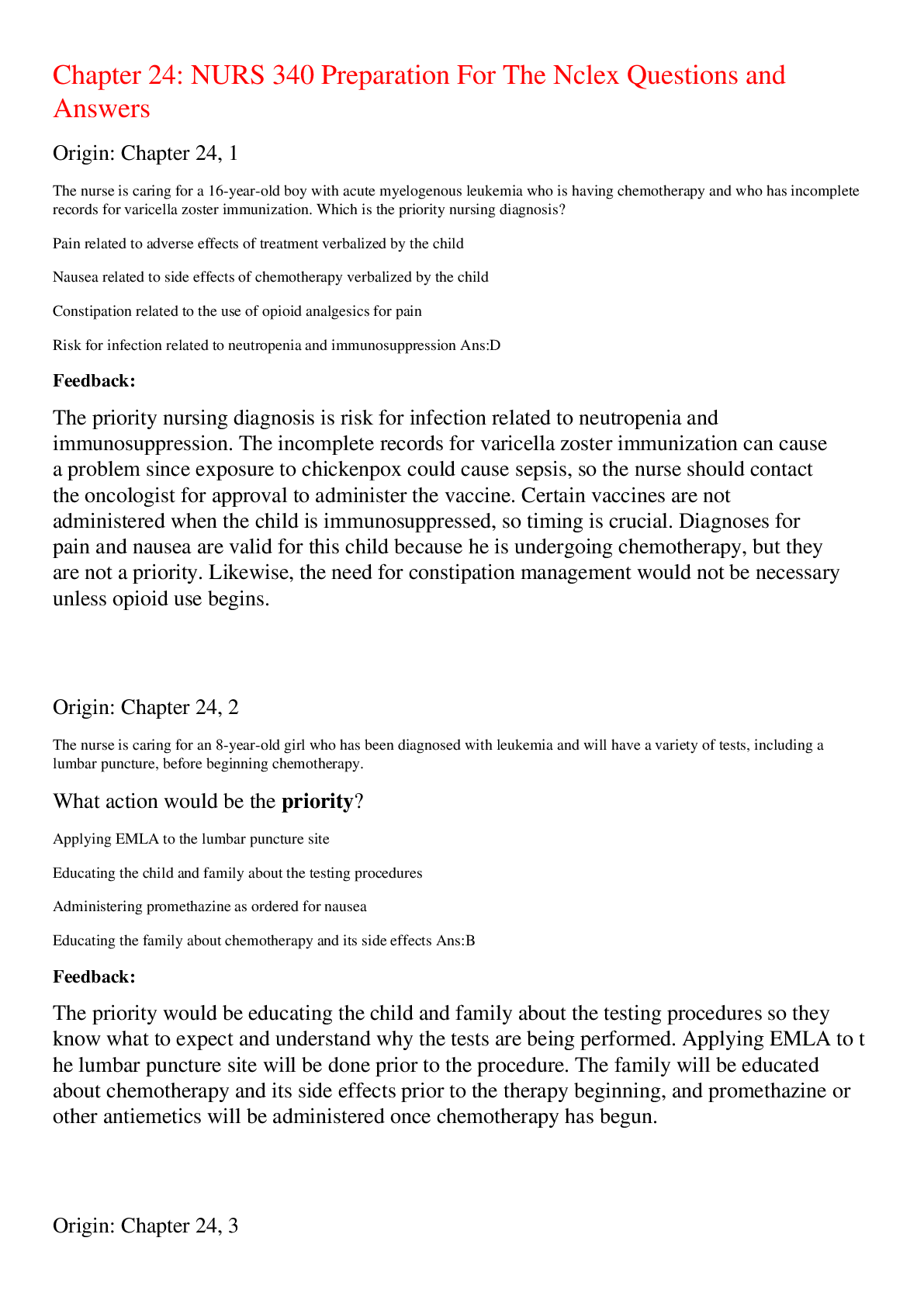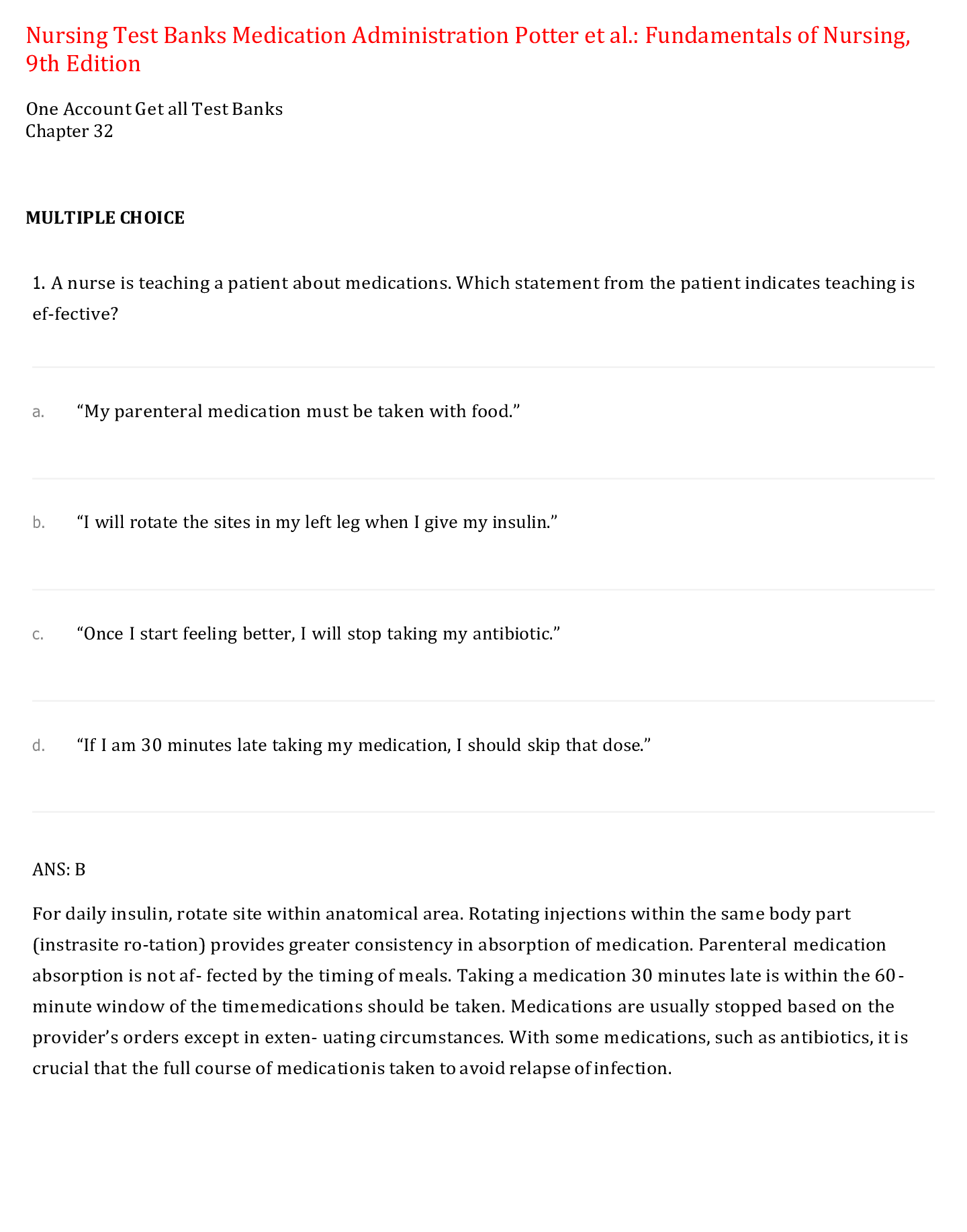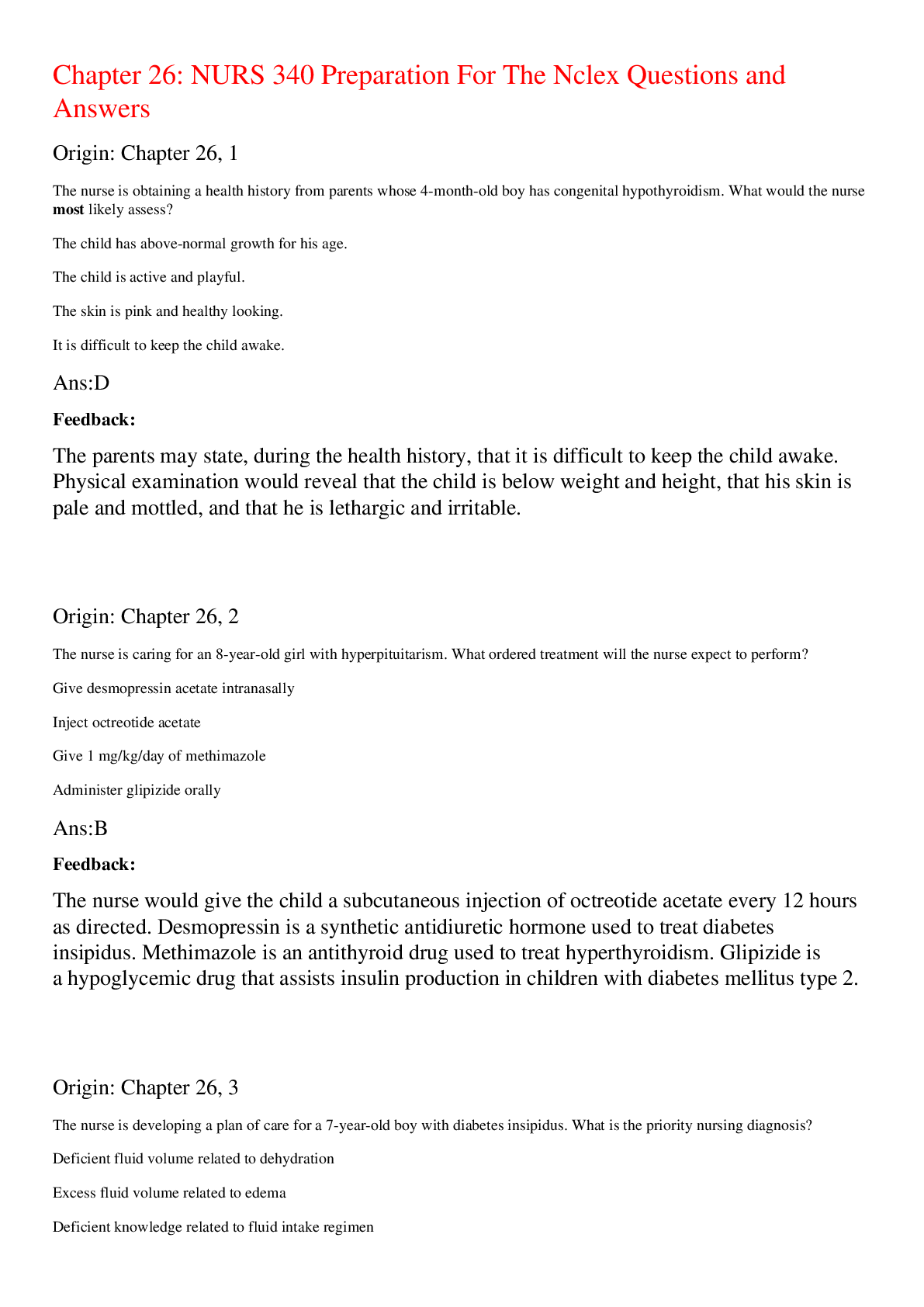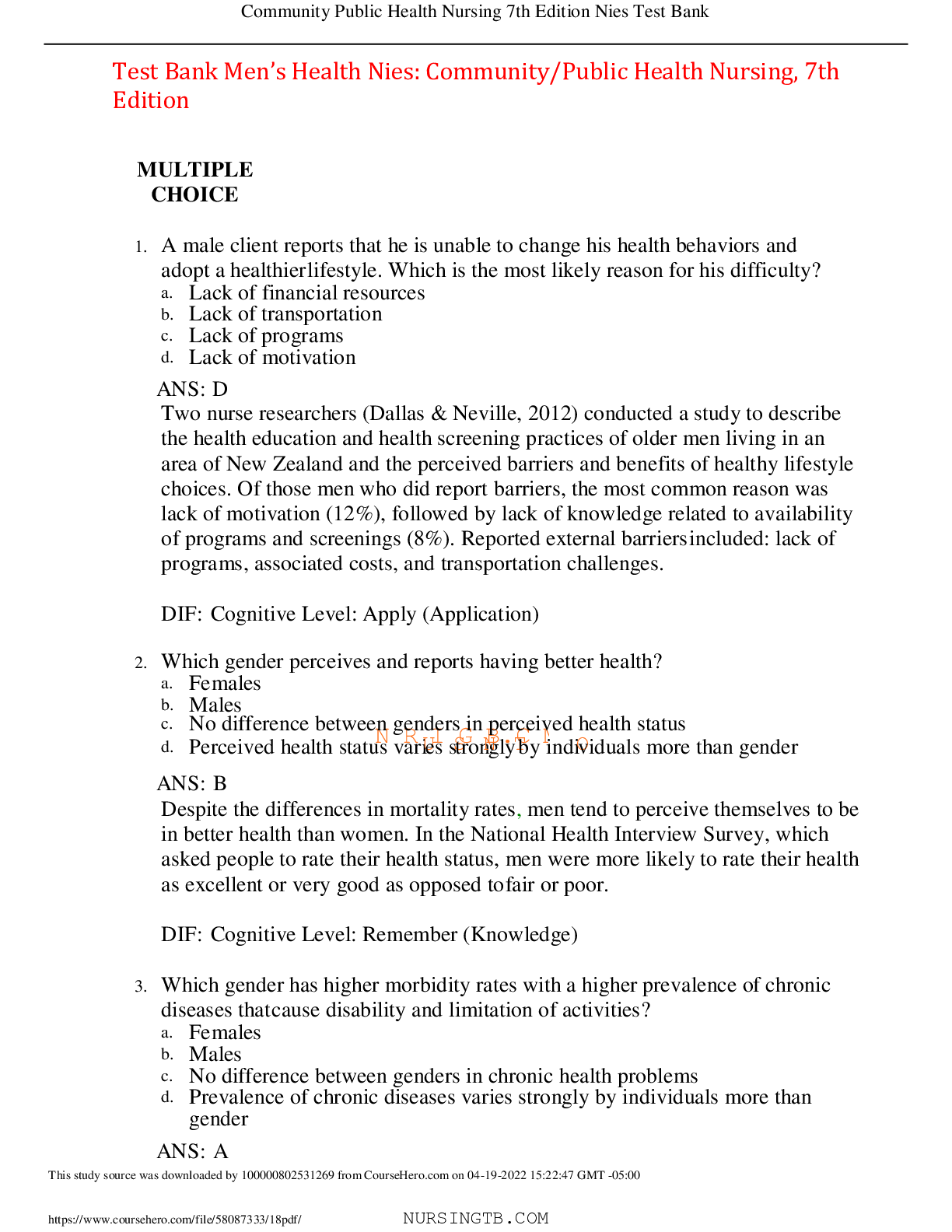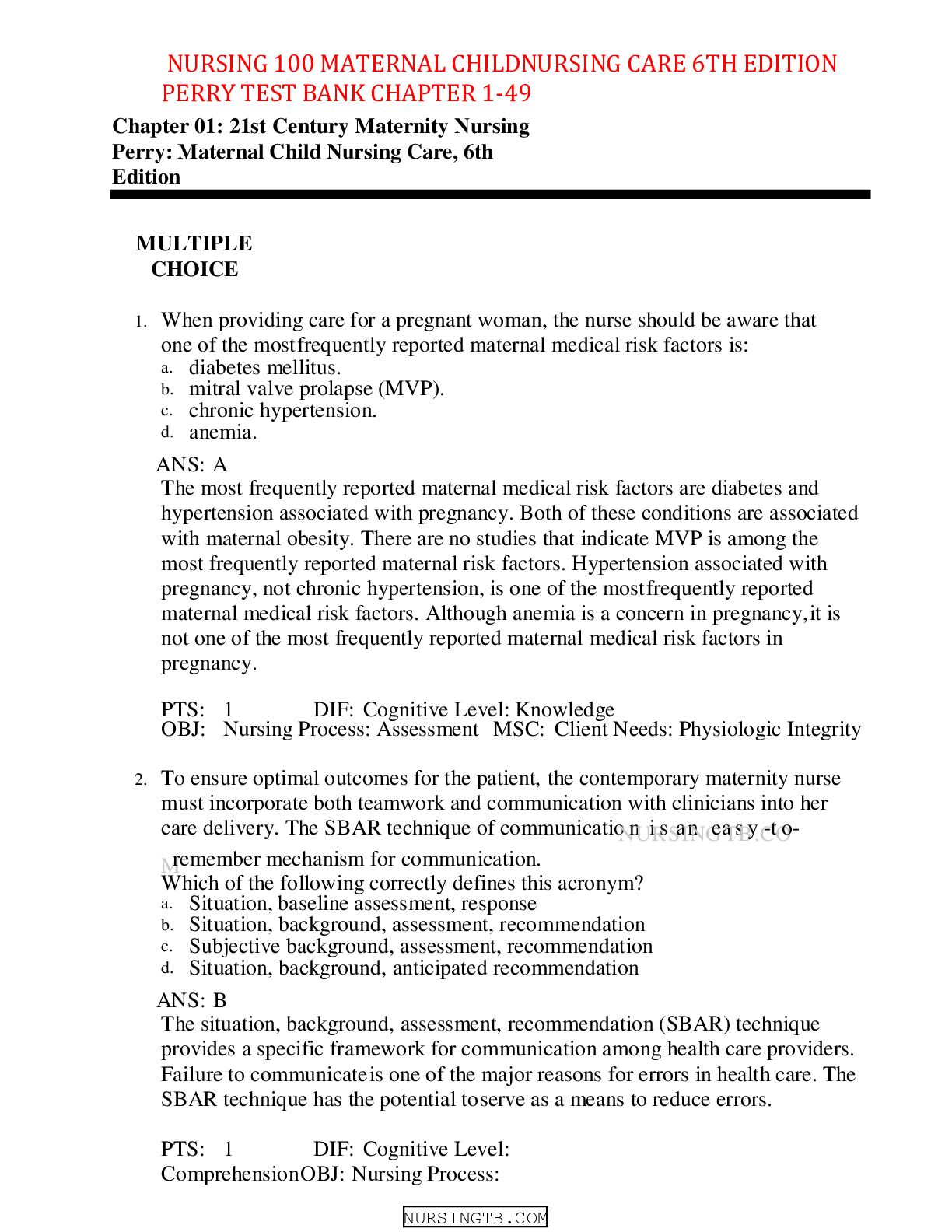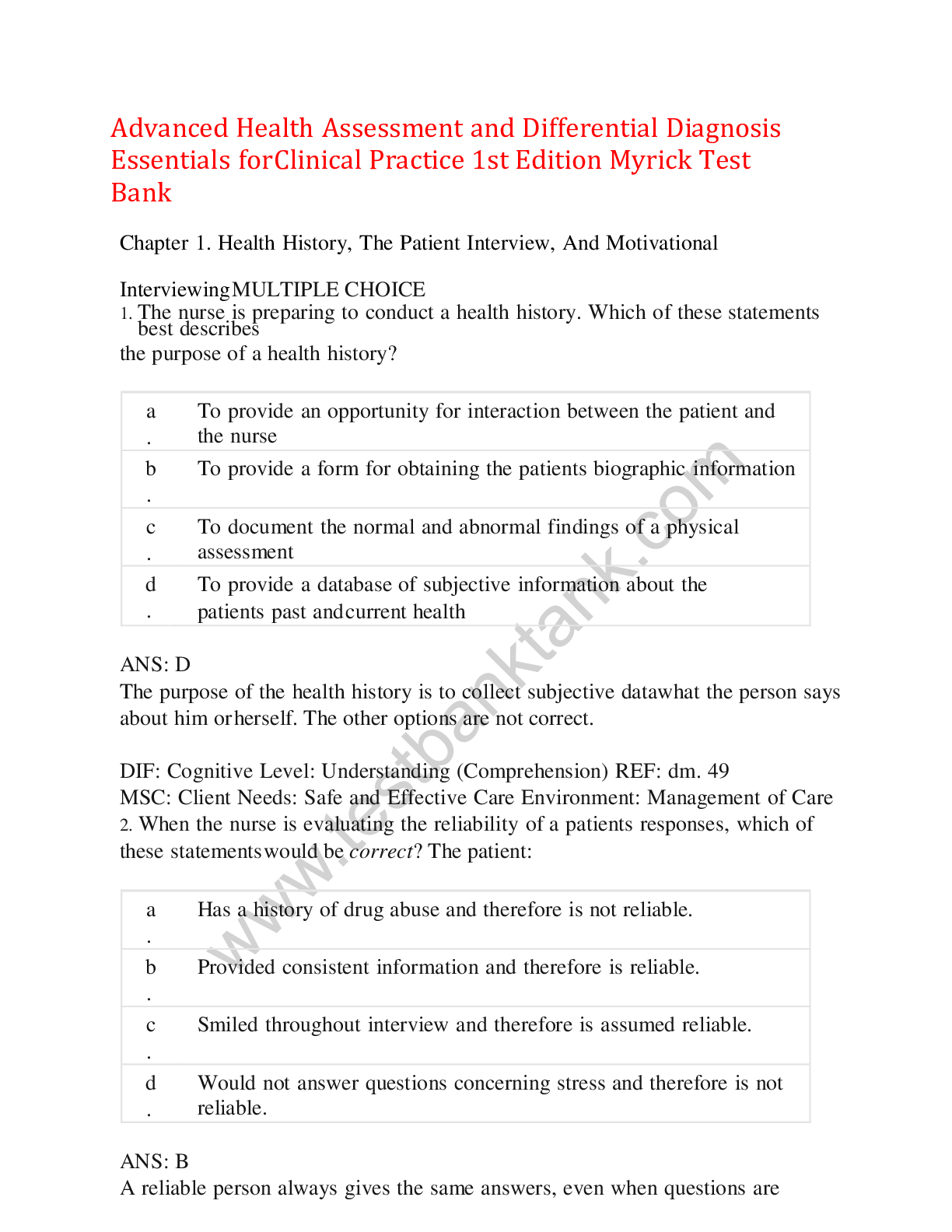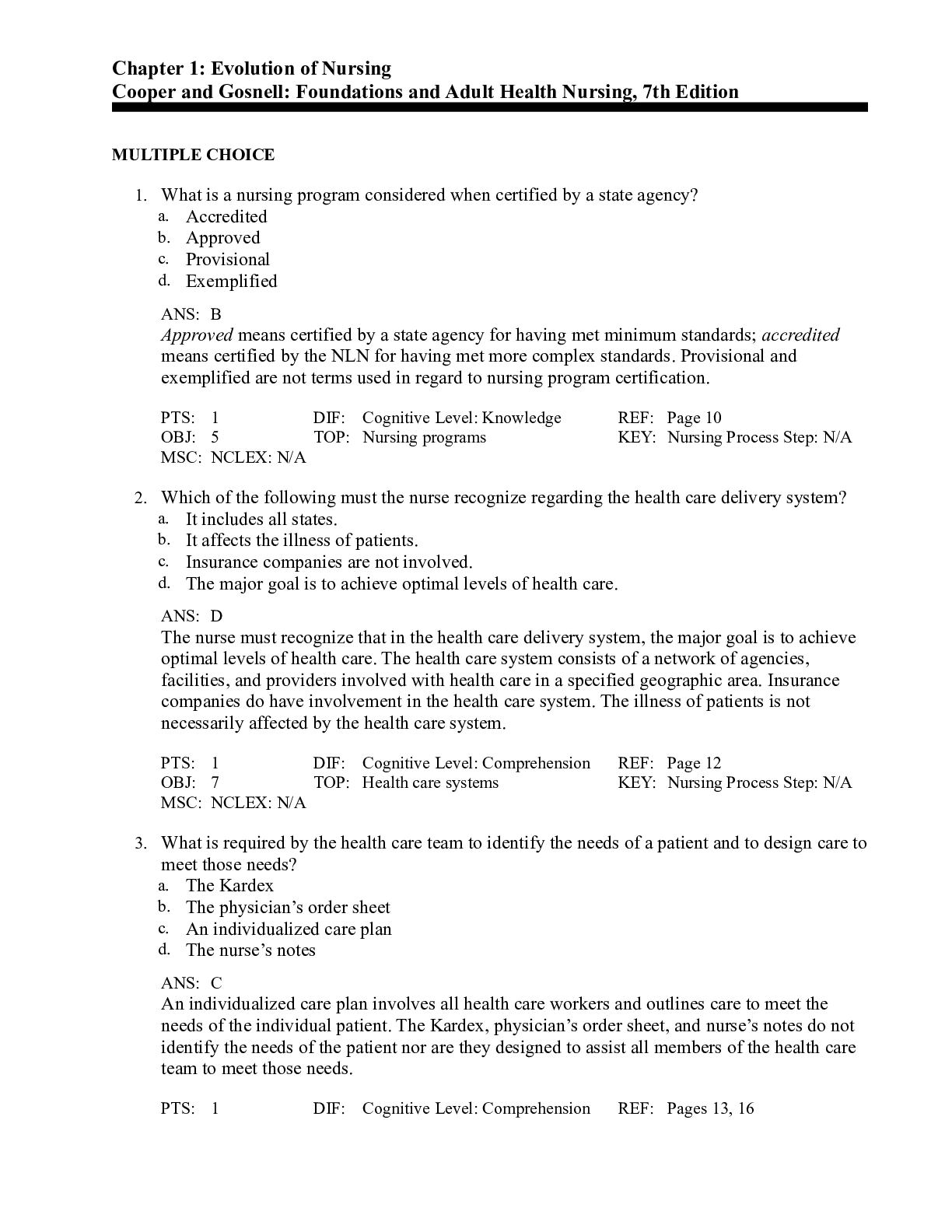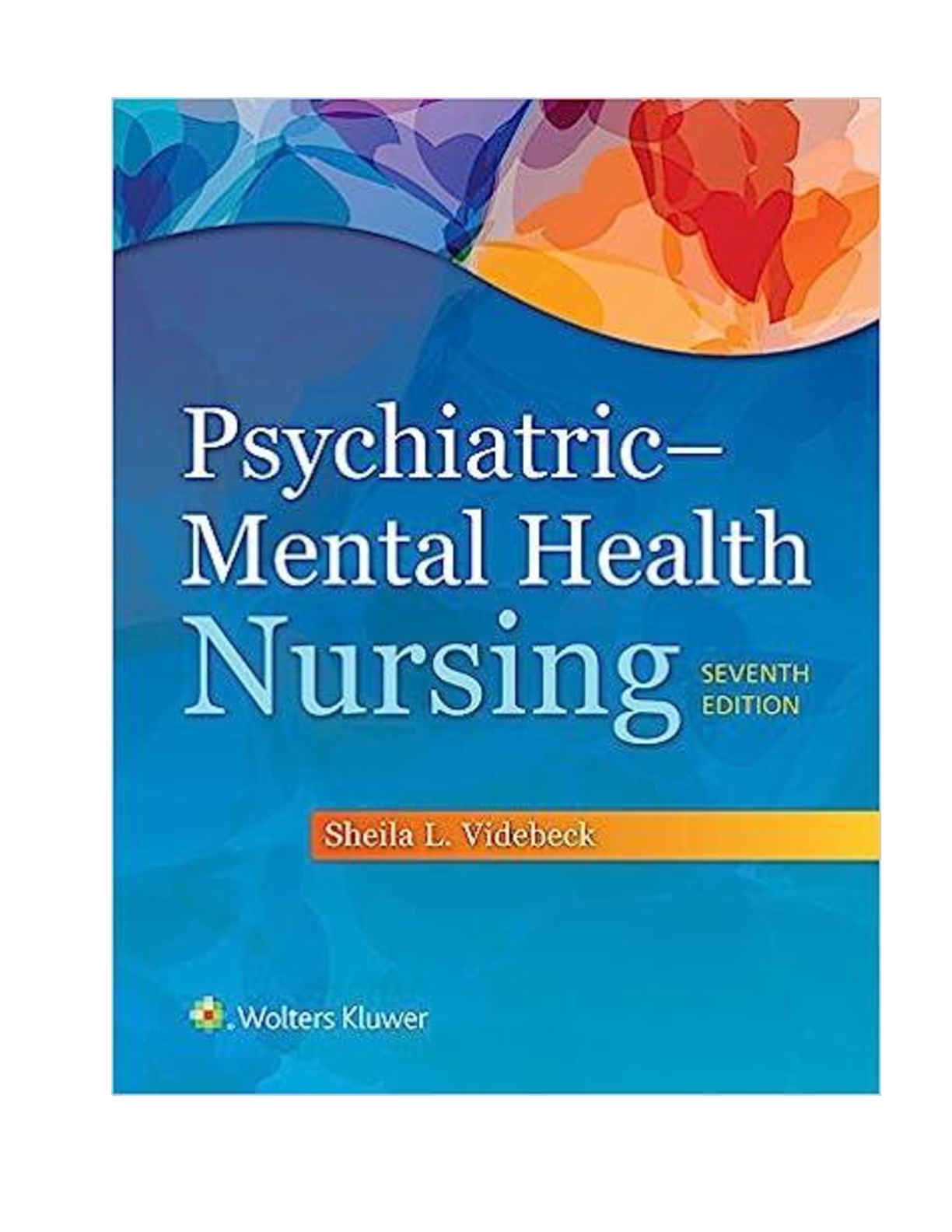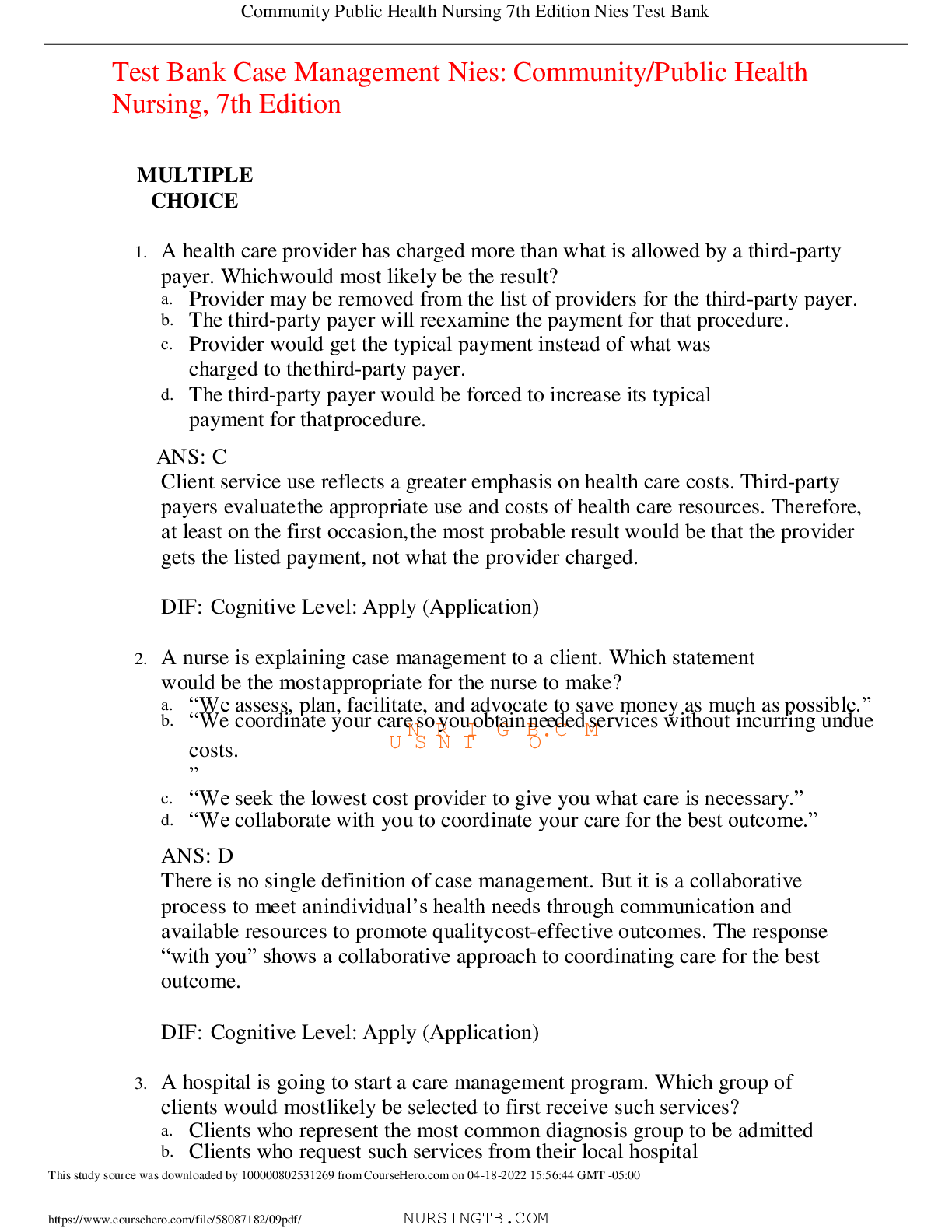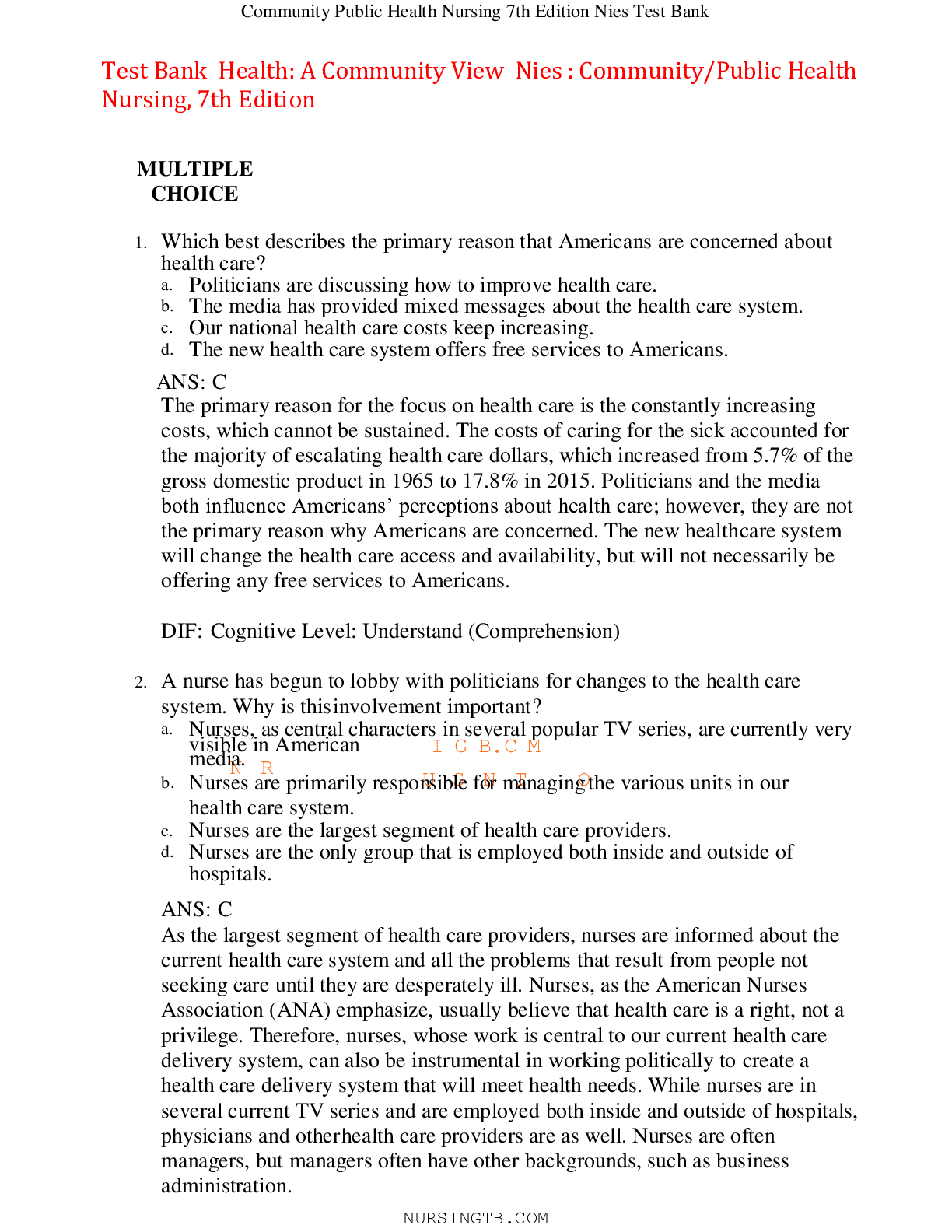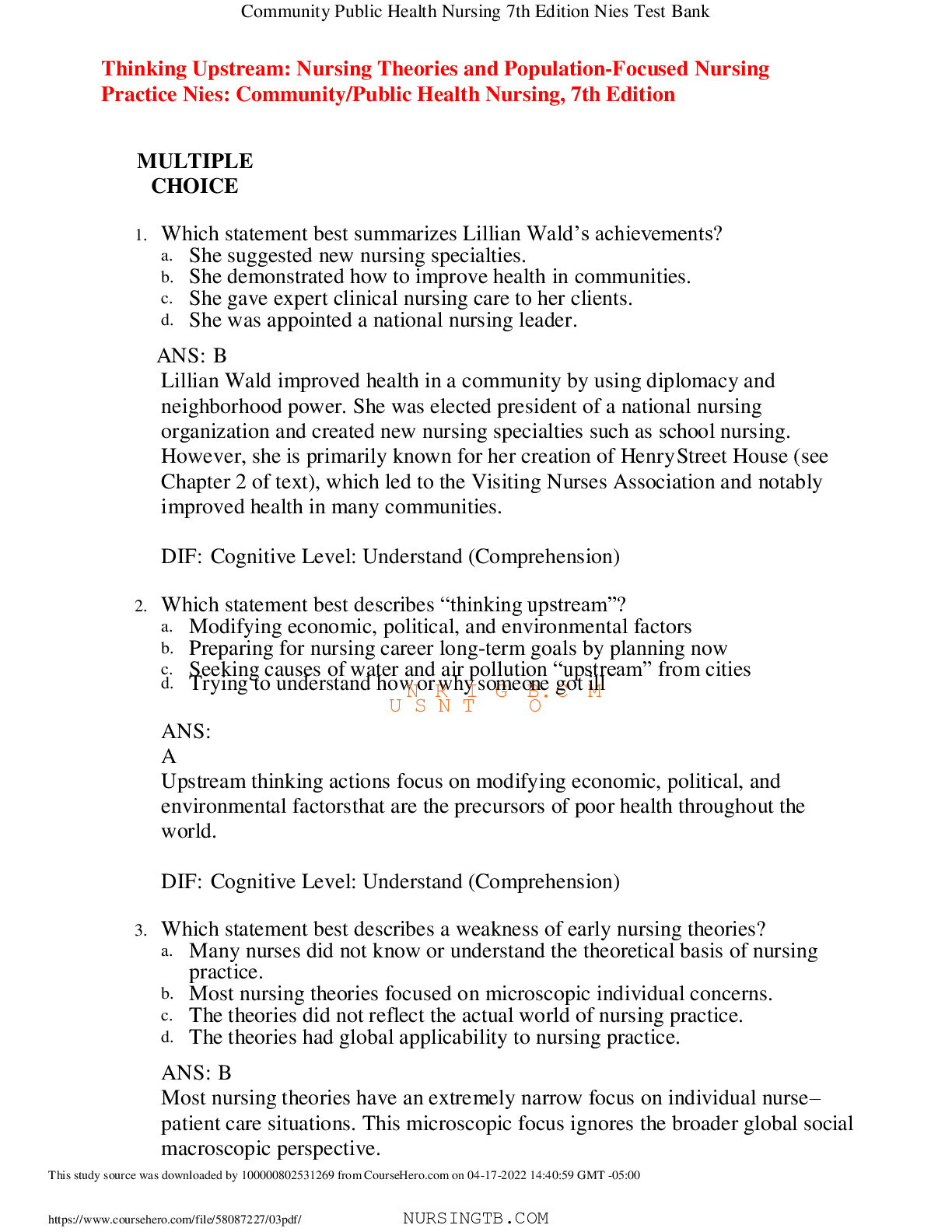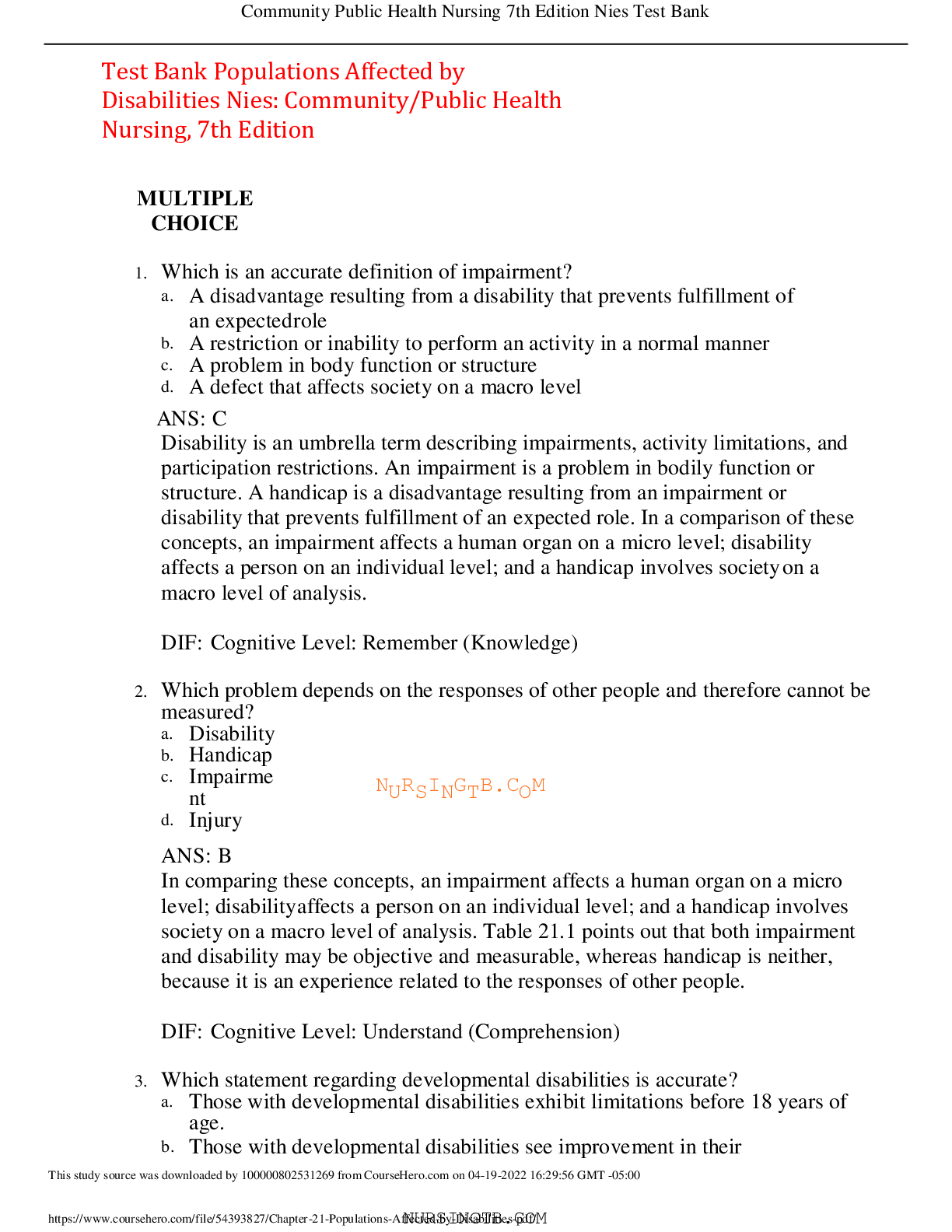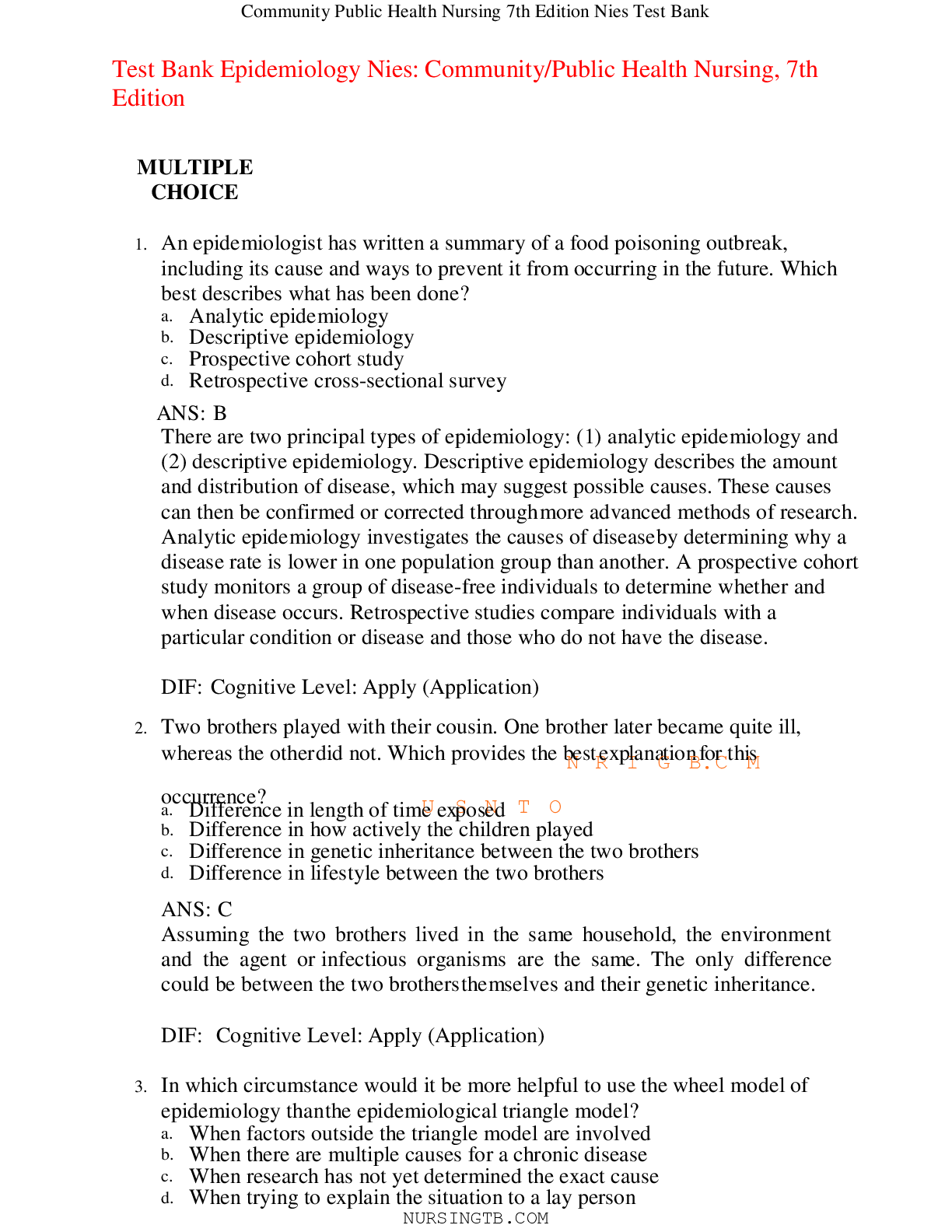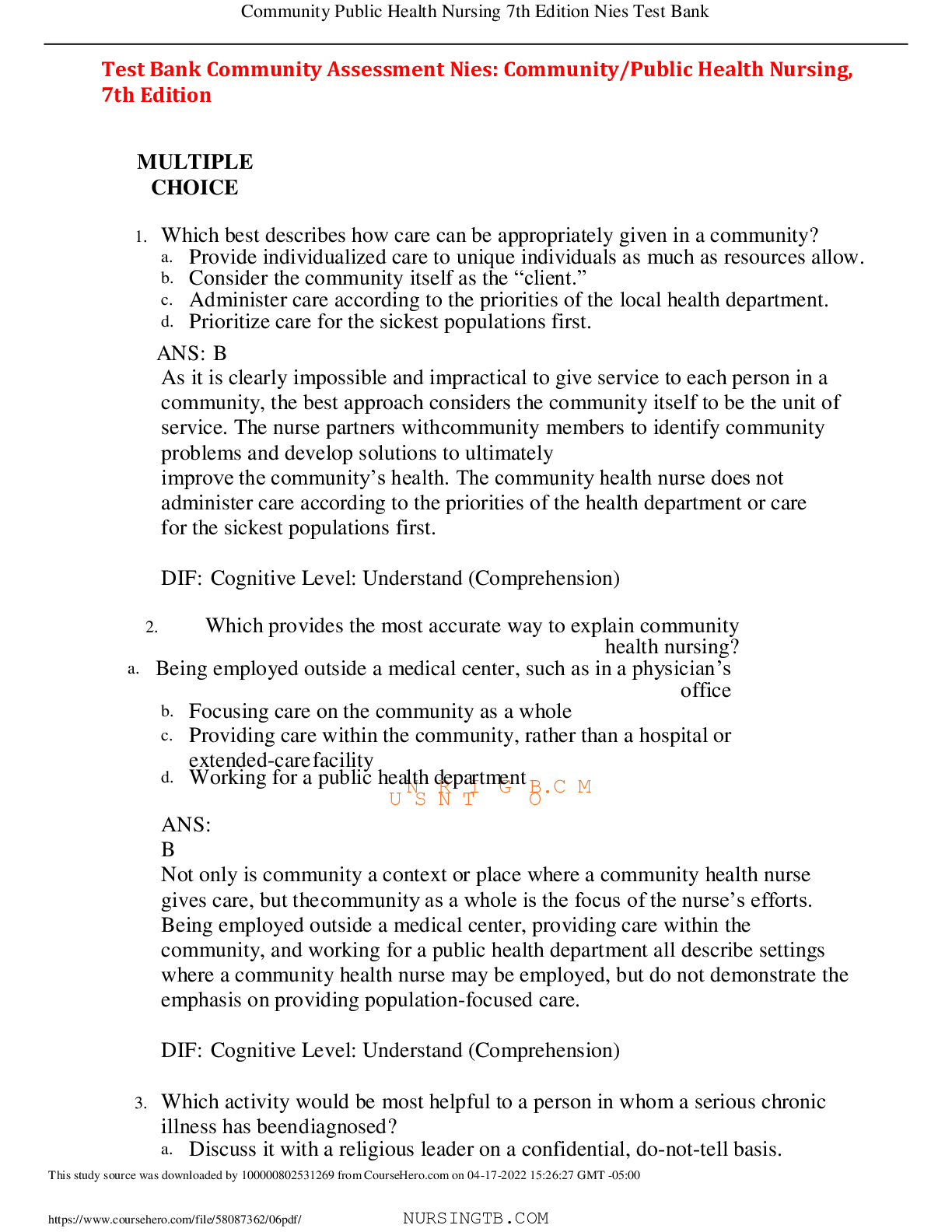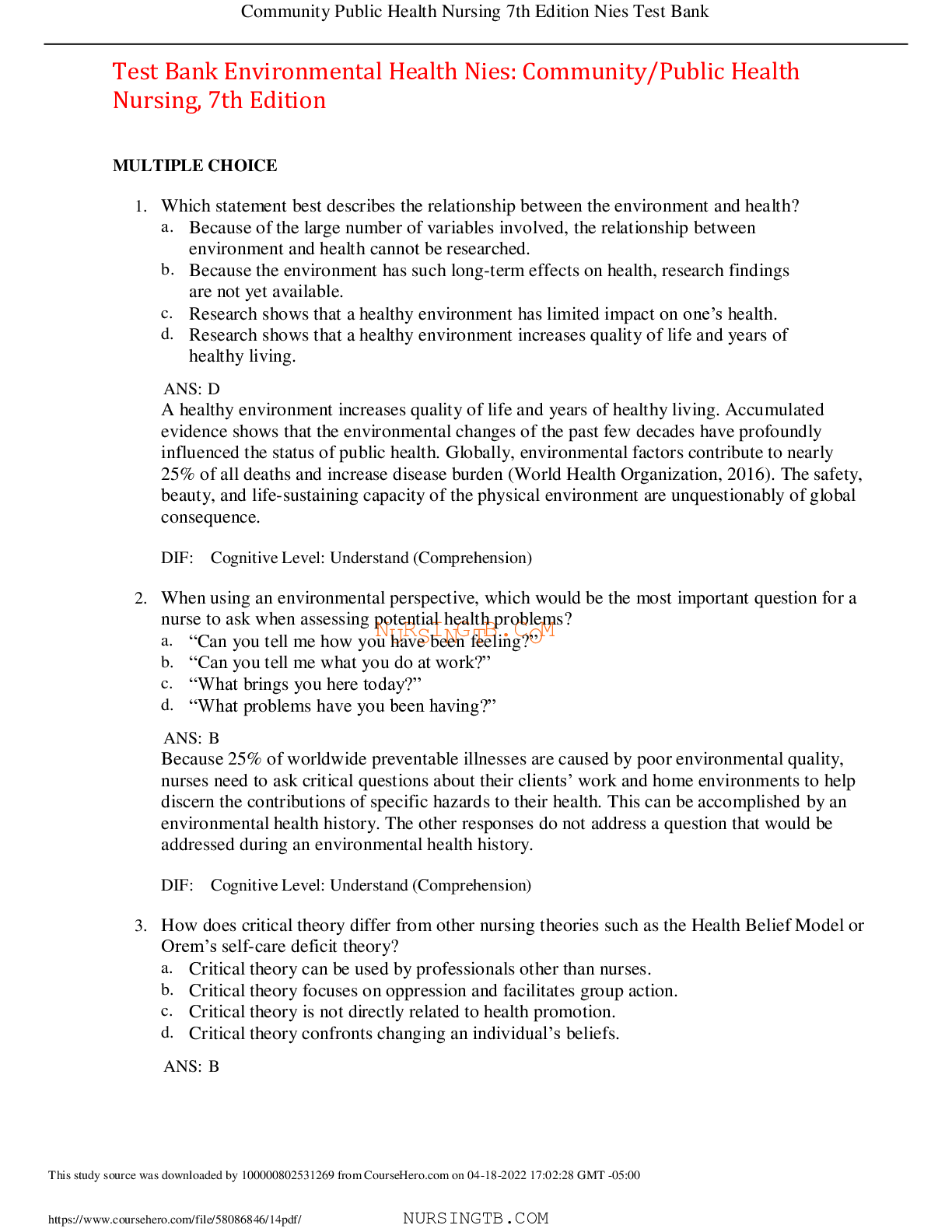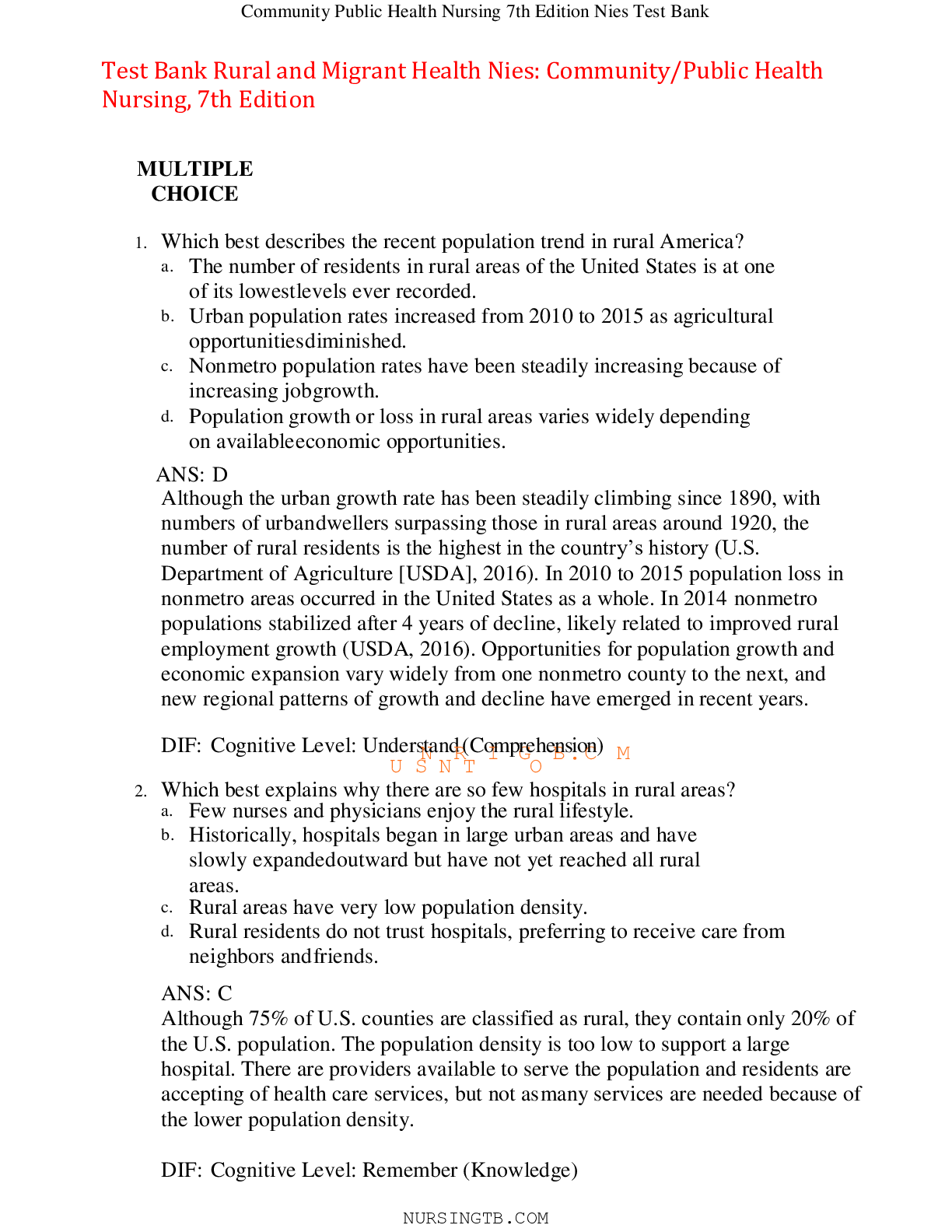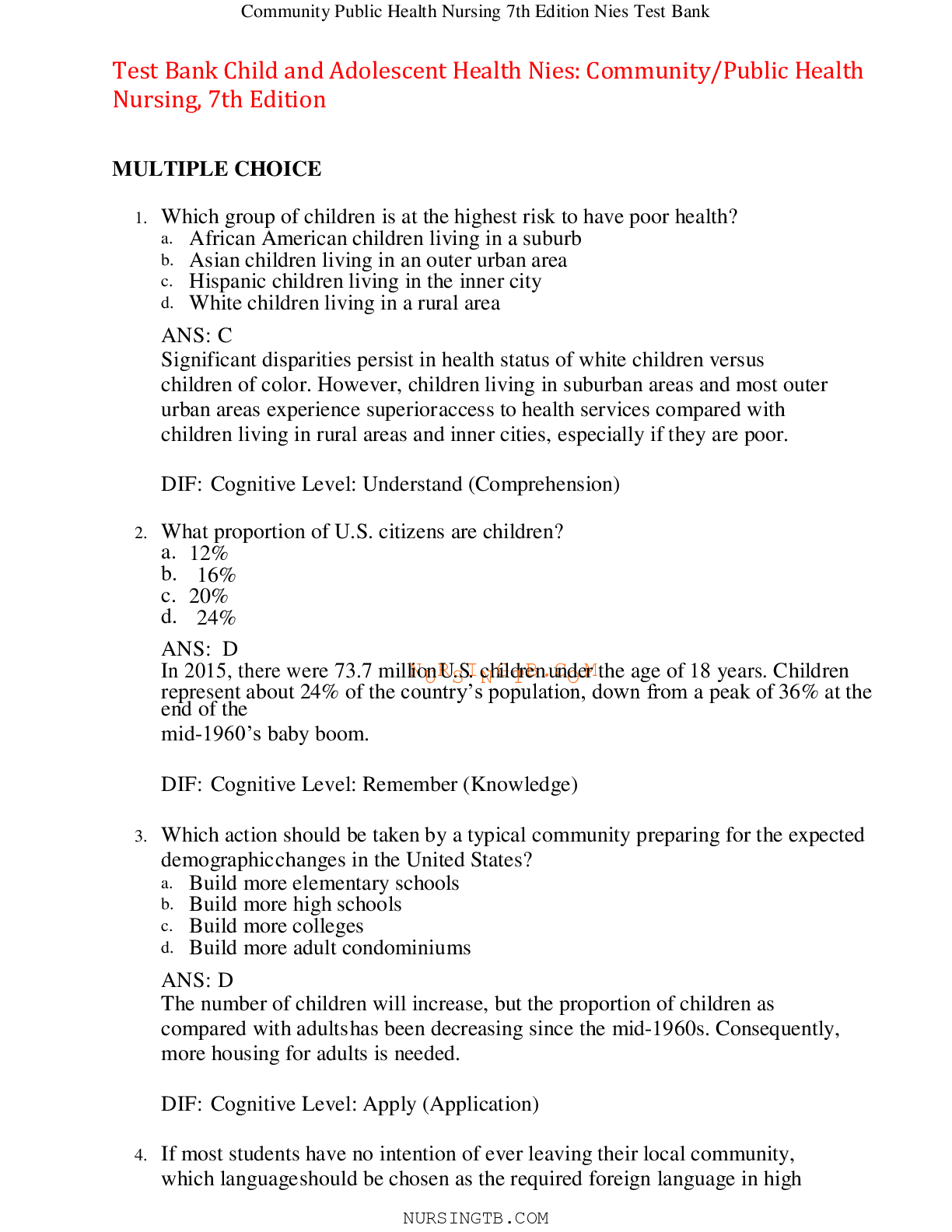*NURSING > TEST BANK > Test Bank Natural and Man-Made Disasters Nies: Community/Public Health Nursing, 7th Edition,100% COR (All)
Test Bank Natural and Man-Made Disasters Nies: Community/Public Health Nursing, 7th Edition,100% CORRECT
Document Content and Description Below
Test Bank Natural and Man-Made Disasters Nies: Community/Public Health Nursing, 7th Edition MULTIPLE CHOICE 1. Which U.S. agency is responsible for overseeing the actions of protecting against... , responding to, recovering from, and preventing the effects of disaster? a. American Red Cross (ARC) b. The Department of Homeland Security (DHS) c. Federal Emergency Management Agency (FEMA) d. The National Incident Management System (NIMS) ANS: D Because of the recognition of the need to be prepared, programs have been created to address the national, state, and local management of disasters. President George W. Bush established the NIMS in 2004. The NIMS provides a systematic, proactive approach for all levels of government and nongovernmental agencies to work seamlessly to prevent, protect against, respond to, recover from, and prevent the effects of disasters (Federal Emergency Management Agency, 2017a). The ARC is not a governmental agency. It is chartered by Congress to provide disaster relief. It works in partnership with FEMA, DHS, the Centers for Disease Control and Prevention, and other local, state, and federal agencies to provide and manage needed services. The DHS was established to realign the existing agencies, groups, and organizations into a single department, focusing on protecting the American people and their homeland. The mission of the FEMA is to support citizens and first responders to ensure that, as a nation, everyone works together to build, sustain, and improve the capacity to prepare for, protect against, rNesUpoRnSdItoN, GreTcoBve.rCfrOomM, and mitigate all hazards. DIF: Cognitive Level: Remember (Knowledge) 2. Which statement best describes how a disaster is the same as or different from an emergency? a. A disaster is personal, whereas an emergency is communitywide. b. An emergency is personal, whereas a disaster is communitywide. c. Both emergencies and disasters are devastating. d. Both emergencies and disasters are failures resulting in extensive insurance claims. ANS: B A disaster is any event that causes a level of destruction, death, or injury that affects the abilities of the community to respond to the incident using available resources. Emergencies differ from disasters in that the agency, community, family, or individual can manage an emergency using their own resources. However, a disaster event may be beyond the ability of the community to respond to and recover from the incident using its own resources. Disasters frequently require assistance from outside the immediate community. The type of emergency or disaster will determine the level of devastation or need for extensive insurance claims to be filed. DIF: Cognitive Level: Understand (Comprehension) 3. A hospital emergency department received a call that multiple casualties were on their way, primarily burns from a large factory fire. Which action should the hospital take immediately? a. Ask the governor of the state to declare the area a disaster area so state help can be obtained b. Call surrounding hospitals to set up burn units, because there will be too many patients for one hospital to manage c. Call in physicians and nursing staff who are experts in burn care d. Get in touch with the American Red Cross to assist families of the victims ANS: C A multiple casualty event is one in which more than two but fewer than 100 individuals are involved. Until more is known, only staff expert in burn care need be asked for assistance. Only a mass casualty event with 100 or more individuals involved requires community or state involvement. DIF: Cognitive Level: Apply (Application) 4. Eight patients were burned in a factory fire. Shortly thereafter, four firefighters were seen with possible smoke inhalation problems. Which best describes how these patients are different from the first patients to arrive? a. Burn patients probably have skin damage, whereas the firefighters have lung damage. b. Burn patients will need extensive care over time, whereas the firefighters can probably stay the night with oxygen treatment and then be discharged. c. The burn patients were direct victims, whereas the firefighters are indirect victims. d. The second set of victims may have scarring, shortness of breath, and persistent hoarseness for the next few days. ANS: C Both sets of victims would have inhaled smoke and have lung damage. The treatment and length of stay would be deterNmUinRedSbIyNthGeTaBm.ouCnOt oMf damage, which may vary from victim to victim. Both sets of victims, depending on the severity of the burns, may have scarring, shortness of breath, and persistent hoarseness for the rest of their lives. A direct victim is an individual who is immediately affected by the event; the indirect victim may be a family member or friend of the victim or a first responder. DIF: Cognitive Level: Apply (Application) 5. Which do terrorists hope to accomplish by causing mass destruction and violence toward innocent persons going about their daily lives? a. Create fear to intimidate and coerce to accomplish a political goal b. Encourage others with similar beliefs to join them and their cause c. Obtain publicity for themselves and their goals d. Obtain increased negotiating power and respect ANS: A The U.S. Code of Federal Regulations defines terrorism as “violent acts or acts dangerous to human life that appear to be intended to intimidate or coerce the civilian population or to influence the policy or conduct of a government.” DIF: Cognitive Level: Understand (Comprehension) 6. Which type of maps is crucial to be included in any disaster plan? a. Communication map showing telephone wires and cell phone towers b. Geographic map showing, for example, roads, highways, and train routes c. Resource map showing potential resources in persons and supplies d. Response maps showing sites of first responders, such as fire stations and police stations ANS: C A resource map is a geographic map that outlines the resources that would be available in or near the area affected by a potential disaster (e.g., potential shelter sites, potential medical sources, and location of equipment that might be needed). DIF: Cognitive Level: Remember (Knowledge) 7. When does disaster management begin? a. Before a disaster occurs b. Immediately after the disaster c. Throughout the disaster period d. When the disaster begins ANS: A When one is aware of the types and characteristics of disasters, the question then becomes: What can be done to prevent, prepare for, respond to, and recover from disasters? Disaster management requires an interdisciplinary, collaborative team effort and involves a network of agencies and individuals to develop a disaster plan that covers the multiple elements necessary for an effective plan. Communities can respond more quickly, more effectively, and with less confusion if the efforts needed in the event of a disaster have been anticipated and plans for meeting them have been identified. The results of planning are that more lives are saved and less property is damaged. Planning ensures that resources are available and that roles and responsibilities of all personnNeUl aRnSd IagNenGcTieBs,.boCthOoMfficial and unofficial, are delineated. DIF: Cognitive Level: Remember (Knowledge) 8. Who is responsible for ensuring the safety and welfare of communities? a. Federal government b. Federal Emergency Management Agency c. Local government d. State government ANS: C The local government is responsible for the safety and welfare of its citizens. Emergencies and disaster incidents are handled at the lowest possible organizational and jurisdictional level. DIF: Cognitive Level: Remember (Knowledge) 9. Which agency should develop a community disaster plan, have emergency drills to test the plan, and determine the proper response? a. Federal Emergency Management Agency (FEMA) b. Office of Emergency Management c. State Disaster Office d. The National Disaster Relief Agency The local Office of Emergency Management involves representatives from all official and unofficial agencies in developing the community disaster plan; developing scenarios to test the plan through drills; and assessing the scope, intensity, and number of casualties (once an incident has occurred) to initiate the proper response. The mission of the FEMA is to support citizens and first responders to ensure that, as a nation, everyone works together to build, sustain, and improve the capacity to prepare for, protect against, respond to, recover from, and mitigate all hazards. There is no specific government agency called the State Disaster Office or the National Disaster Relief Agency. DIF: Cognitive Level: Remember (Knowledge) 10. When would the National Guard become involved in a disaster? a. When the Federal Emergency Management Agency requests such assistance b. When the local government requests help keeping order in the community c. When the president has declared the area a national disaster d. When the state has been asked to help an overwhelmed community ANS: D When a disaster overwhelms the local community’s resources, then the state’s department or office of emergency management is called for assistance. Before an event, state officials provide technical support for prevention, preparedness, response, and recovery. State officials are on scene at disaster events to facilitate coordination of state resources and to disseminate information. In some cases, the National Guard may be called in to aid the community. DIF: Cognitive Level: Understand (Comprehension) 11. Which best describes the mission of the U.S. Department of Homeland Security (DHS)? a. To consolidate all existing UageSncieNs, gTroups, aOnd organizations into a single department b. To distribute federal financial aid to disaster-stricken areas c. To enable appropriate response to assist a state having a disaster d. To prevent terrorism and ensure resilience to disasters ANS: D There are five homeland security missions: prevent terrorism and enhance security, secure and manage U.S. borders, enforce and administer immigration laws, safeguard and secure cyberspace, and ensure resilience to disasters. This agency was created to realign the existing agencies, groups, and organizations into a single department, focusing on protecting the American people and their homeland, but this is not the mission of the agency. The Federal Emergency Management Agency distributes federal financial aid to disaster-stricken areas and is responsible to enable the appropriate response to assist a state having a disaster. DIF: Cognitive Level: Understand (Comprehension) 12. Which action should be taken during a biological attack? a. Close doors and windows and turn off all ventilation b. Seek medical attention if you become sick c. Develop a family emergency plan d. Keep a written record of everything that you have eaten During a biological attack one should: move away quickly, wash with soap and water, contact authorities, listen to the media for official instructions, and seek medical attention if you become sick. If a chemical attack were occurring, the first action would be to close doors and windows. In the case of a biological attack, one should move quickly away from the area. A family emergency plan should be developed well in advance of a biological attack. Unless directed by the authorities, it should not be necessary in any type of an attack to keep a written record of everything that is eaten. DIF: Cognitive Level: Understand (Comprehension) 13. Which statement best describes how the American Red Cross (ARC) is different from the Federal Emergency Management Agency (FEMA) or the National Incident Management System? a. Funding includes only voluntary contributions. b. It emphasizes being prepared for emergencies, not just reacting to them. c. It has only volunteers as staff. d. It is a nongovernmental volunteer agency. ANS: D The ARC is not a governmental agency. The ARC, however, is chartered by Congress to provide disaster relief. It works in partnership with FEMA, the Department of Health and Human Services, the Centers for Disease Control and Prevention, and other federal agencies to provide and manage needed services. The ARC receives federal money as well as voluntary contributions. The ARC has both paid and volunteer staff. All of these agencies focus on preparation for disasters (not emergencies) as well as reacting after they occur. DIF: Cognitive Level: UndersNtandR(CoImpGreheBns.ioCn) M U S N T O 14. Who should create a disaster plan including emergency supplies and where to meet in case of an emergency? a. All families b. All government officials c. All public health employees d. Members of Congress and the Supreme Court ANS: A The American Red Cross publishes many pamphlets and educational materials to help individuals, families, neighborhoods, schools, and businesses prepare for potential disasters. The key actions it recommends are: (1) identify potential disaster events, (2) create a disaster plan for sheltering in place or for evacuation, (3) assemble a disaster supplies kit, and (4) practice and maintain the plan. The disaster plan should include an emergency communications plan, a predetermined meeting place for family members or significant others, and plans for care of pets in the event that evacuation is required. DIF: Cognitive Level: Remember (Knowledge) 15. Which best describes how a community will know whether its disaster plan is adequate? a. After a disaster occurs and reports of deaths and injuries are fairly accurate b. By following practice drills involving various feasible scenarios as an initial step of planning c. When federal experts have reviewed and approved the plan d. When state officials have reviewed and approved the plan ANS: B For a plan to be effective, it must be tested by having different disaster scenario drills. The more times realistic scenarios are created to test the plan in actual practice sessions, and not just tabletop or paper drills, the more problems with the plan will be identified and solutions for those problems can be found. Without practice drills, plans may have many unrecognized faults and, as a result, many more individuals may be harmed and communities damaged when an actual disaster occurs. DIF: Cognitive Level: Understand (Comprehension) 16. An earthquake has hit and buildings are knocked down; people are injured and crying for help. Looters have already started grabbing essential resources. Which action should the community take first? a. Send in ambulances to transport injured persons to medical facilities b. Send in media personnel to share the event and begin efforts to obtain donations for the injured c. Send in medical personnel to administer first aid and triage the injured d. Send in law officials to secure the area and ensure the safety of the victims ANS: D Before search and rescue should begin, safety must be considered. In some instances, if a criminal action is suspected, law officials will be among the first to respond to secure the area and possibly gather evidence. While the area is being checked and then cleared of potential threats, a staging area can be set up at or near the site of the incident to direct onsite activities. Search and rescue of victims can begin once clearance is given, a disaster triage area is established, and an emergencNyUtrReaStmIeNnGt aTreBa.isCsOetMup to provide first aid until transportation for victims to hospitals or health care facilities for treatment can be coordinated. DIF: Cognitive Level: Apply (Application) 17. A man walked to the staging area after an earthquake crying that he was hurt. A triage nurse noted he had cuts, abrasions, and an open (bone was seen) fractured arm. Which action should be taken next? a. Put a green tag on his shirt and he can get in line to wait his turn for medical treatment b. Put a yellow tag on his shirt and then await transport to a medical facility c. Put a black tag on his shirt and give him a chair to rest in until something can be done d. Put a green tag on his shirt and ask him to use his good arm to help others make it to the staging area ANS: B Green on the triage tag is for the walking wounded or those with minor injuries (e.g., cuts and abrasions) who can wait several hours before they receive treatment; yellow is for those with systemic but not yet life-threatening complications, who can wait 45 to 60 minutes (e.g., simple fractures); red is considered top priority or immediate and is for those with life-threatening conditions but who can be stabilized and have a high probability of survival (e.g., amputations); and black is for the deceased or for those whose injuries are so extensive that nothing can be done to save them (e.g., multiple severe injuries). DIF: Cognitive Level: Apply (Application) 18. Which step should the nurse take first when triaging a victim of a disaster? a. Assess mental status b. Assess perfusion c. Assess respirations d. Assess blood pressure ANS: C To assess an individual within the 1-minute guideline, the START system uses three characteristics. First, respirations are checked; then perfusion by pinching the nail bed and observing the reaction; and, last, mental status is checked by asking the individual a question. Assessing blood pressure is not part of the 1-minute guideline. DIF: Cognitive Level: Understand (Comprehension) 19. Which disaster would most likely cause the most long-lasting mental health concerns for its victims? a. For the fourth year in a row a flood hit an area, demolishing several houses, but families heard the warning siren and evacuated in time. b. A forest fire was deliberately set but was not a major concern until the fire suddenly changed direction and people attempting to evacuate at the last minute were burned in their cars. c. A tsunami hit the beach with unbelievable force, water sweeping over the entire harbor, although most boats had been moved to deep water. d. A volcano erupted and lava destroyed the main road to the village where several houses burned, but no one UdiedSin Nthe eTruptionO. ANS: B Research has identified four keys to gauging the mental health impact of such events, any two of which may result in severe, lasting, and pervasive psychological effects. The key factors are: (1) extreme and widespread property damage; (2) serious and ongoing financial problems; (3) high prevalence of trauma in the form of injuries, threat to life, and loss of life; and (4) when human intent caused the disaster. Because the fire was deliberately set and lives were lost, that disaster will be more disruptive than disasters when only property was damaged. DIF: Cognitive Level: Apply (Application) 20. Which type of behaviors would a nurse expect to see when a disaster first strikes a community? a. A sense of all being okay and that one can rebuild and go on b. Anger and despair that help being offered is insufficient, slow, and inadequate c. Everyone trying to help strangers, as well as their neighbors, survive d. People involved sharing their stories and reliving what occurred ANS: C The classic four phases of a community’s reaction to a disaster are the heroic phase, honeymoon phase, disillusionment phase, and reconstruction phase. During the heroic phase, nearly everyone feels the need to rush to help people survive the disaster. DIF: Cognitive Level: Understand (Comprehension) 21. A friend who was raped and beaten appeared to be coping well. However, she recently dropped out of school and shared with the nurse that she is having nightmares where it happens all over again, and these nightmares are becoming impossible to live with. Which would be the concern of the nurse? a. A late psychological reaction of despair and hopelessness b. Depression that no one rescued her and saved her from the traumatic event c. Guilt and concern over what she could possibly have done to invite such an event d. Posttraumatic stress syndrome disorder (PTSD) ANS: D PTSD is a psychiatric disorder that can occur after an individual’s experiencing or witnessing a life-threatening event. People who suffer from PTSD often relive the experience through nightmares and flashbacks. The social and psychological symptoms can be severe enough, and last long enough, to significantly impair a person’s daily life. DIF: Cognitive Level: Apply (Application) 22. As a nurse and a citizen, what is the nurse’s additional responsibility in relation to disasters? a. Assume the nurse will be asked to volunteer to assist the American Red Cross with helping care for disaster victims b. Be aware if there is an unusual increase in the number of people seeking care with similar symptoms c. Expect and plan for the possibility of being called to report to work for additional work efforts in caring forNtheRsickIanGd inBju.reCd M d. Expect to be a role model iUn prSepaNringTfor andOreacting to a disaster ANS: B As a nurse, one is expected to be informed regarding the Guidelines for Early Detection for Biochemical Terrorist Incidents, including noting if there is a sudden increase in a particular disease, an unusual number of persons seeking care with similar complaints, clusters of patients from a single location, or a person presenting with an uncommon disease. DIF: Cognitive Level: Understand (Comprehension) 23. Which set of symptoms would be unexpected after a disaster? a. Confusion, disorientation, indecisiveness, and memory loss b. Depression, fear, or just numbness c. Fatigue with headaches, nausea, and dizziness d. Irritable, suspicious, argumentative, and inappropriate e. No unusual feelings or behavior ANS: E Common responses to disasters include all sorts of cognitive, emotional, physical, and behavioral symptoms. Therefore, to have no unusual feelings or behavior would indeed be unexpected. DIF: Cognitive Level: Apply (Application) MULTIPLE RESPONSE 1. Which disasters are considered natech (natural-technological) disasters? (Select all that apply.) a. Constant rain led to mud slides, and whole neighborhoods were buried. b. An earthquake caused structural collapse of bridges and highways in the area. c. People stampeded out of the overcrowded arena, trampling people who had fallen. d. River flooding resulted in overflow of the sewage plant and contaminated drinking water throughout the city. e. The tsunami washed out all the power and telephone lines throughout the downtown area of the city. f. Volcanic eruption covered the town with ash, making it difficult to breathe. ANS: A, B, D, E Disasters are identified as natural, man-made, or a combination of both. A natech disaster is a natural disaster that creates or results in a widespread technological problem. Examples of natech disasters would include whole neighborhoods being buried by mudslides, earthquakes causing structural collapse of roadways or bridges, river flooding resulting in an overflow of the sewage plant and contaminated drinking water, and a tsunami washing out all of the power and telephone lines. People stampeding out of a crowded arena do not involve a disaster that results in a widespread technological problem, nor does a volcanic eruption that makes it hard to breathe. DIF: Cognitive Level: Apply (Application) 2. Which best describes why earthquakes would be more frightening than floods to many people, even though both can cause extensive damage? (Select all that apply.) a. Death rate and scope are hiUgheSr inNeartThquakeOs. b. There is a higher frequency of earthquakes. c. Imminence of earthquakes is unknown. d. It is not possible to prevent an earthquake. e. The intensity of earthquakes is higher. f. The predictability of earthquakes is lower. ANS: C, D, F Death rate, intensity, and frequency depend on location and other factors. Hawaii, for example, has frequent earthquakes with little damage resulting. However, earthquakes cannot be predicted or prevented, whereas flooding can usually be predicted and most communities have taken steps to avoid or at least lessen the damage from floods. The frequency or intensity of earthquakes is not higher than that of flooding. DIF: Cognitive Level: Remember (Knowledge) 3. Which are the responsibilities of the Centers for Disease Control and Prevention (CDC) in relation to disasters? (Select all that apply.) a. Contacting family members with up-to-date information regarding victims and their condition b. Coordinating local services to prevent duplication and fragmentation c. Delivering first aid and arranging for prescription medications that were lost to be replaced d. Detecting disease outbreaks, their cause, and risk factors, and implementing interventions for control e. Ensuring that drinking water, food, shelter, and medical care are available to victims f. Setting up safe and comfortable disaster shelters (emergency housing) for families ANS: D, E After the rescue of survivors has been accomplished, the Department of Health and Human Services (HHS), the CDC—which is responsible to the HHS—steps in to ensure that clean drinking water, food, shelter, and medical care are available for those affected. Preparedness includes vigilance and reporting of suspicious illnesses (e.g., signs and symptoms of biological agents, food-borne diseases, and communicable diseases) in the community by physicians and nurses in local health care facilities or private offices and clinics. Public health officials then have the responsibility of detecting outbreaks, determining the cause of illness, identifying the risk factors for the population, implementing interventions to control the outbreak, and informing the public of the health risks and preventive measures that need to be taken. Many of the other choices are actually services offered by the American Red Cross. DIF: Cognitive Level: Understand (Comprehension) NURSINGTB.COM [Show More]
Last updated: 1 year ago
Preview 1 out of 19 pages
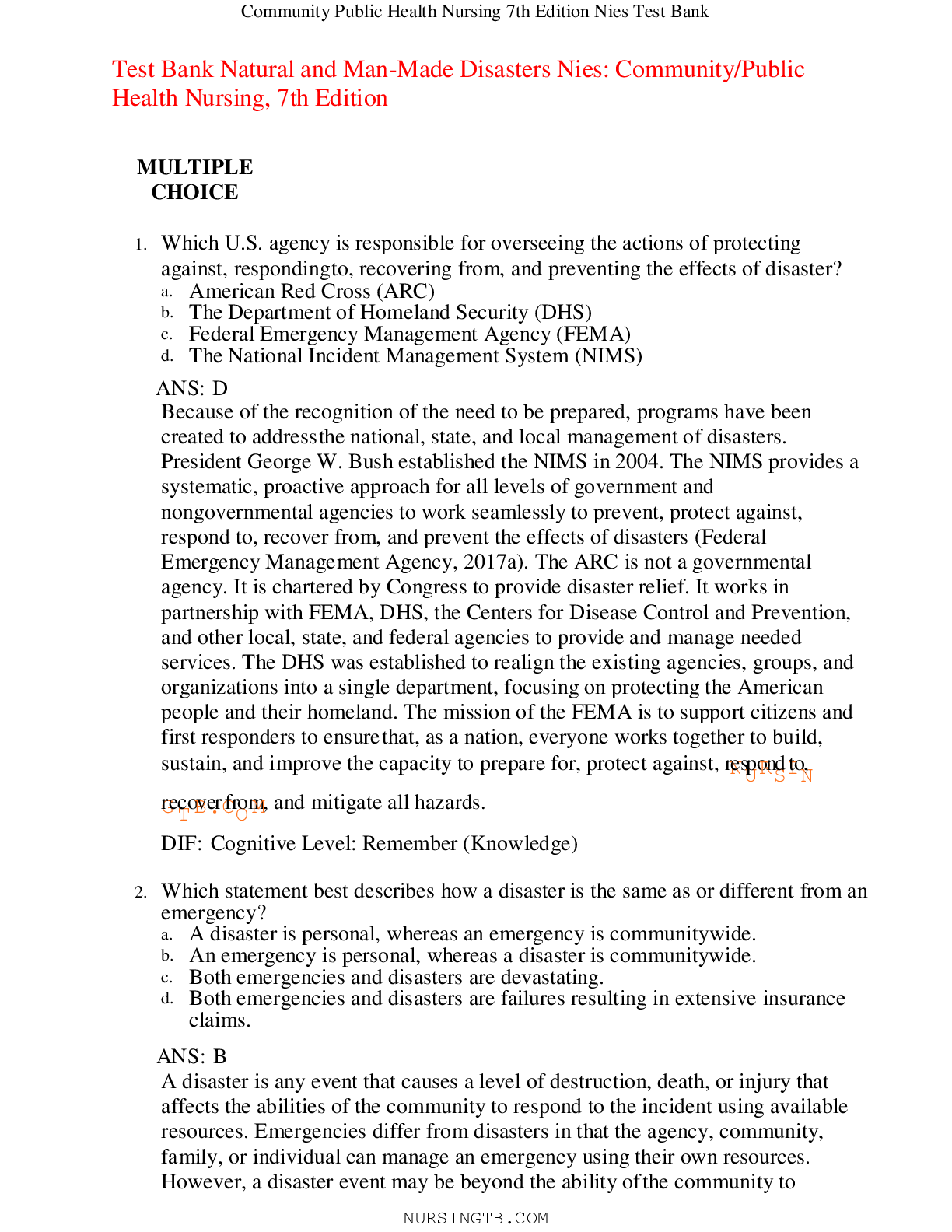
Reviews( 0 )
Document information
Connected school, study & course
About the document
Uploaded On
May 03, 2022
Number of pages
19
Written in
Additional information
This document has been written for:
Uploaded
May 03, 2022
Downloads
0
Views
36




